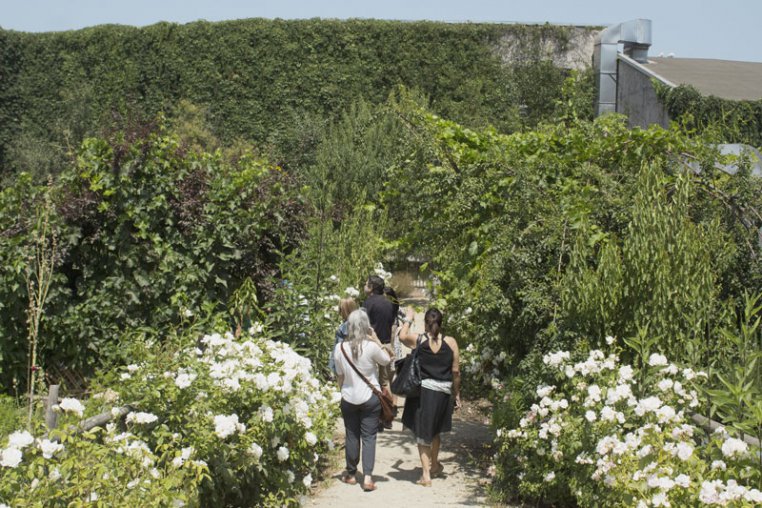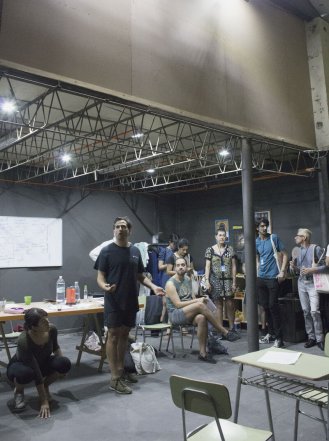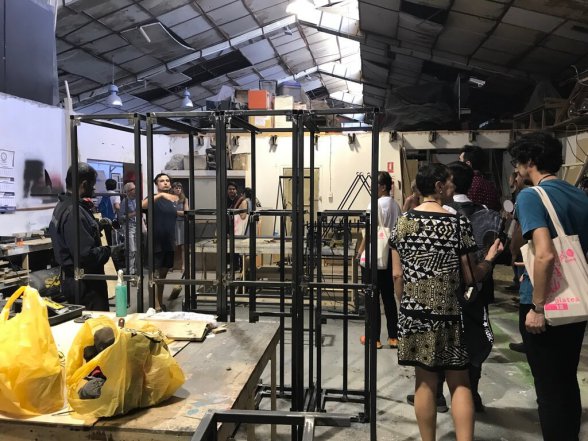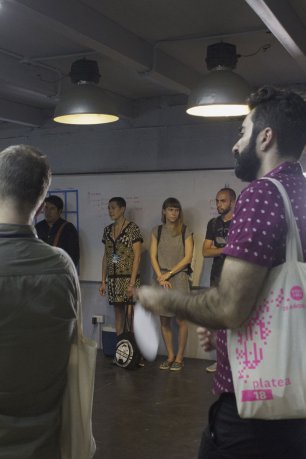Visits to Creative Centers in PLATEA18: New places for resistance
Visits to Creative Centers in PLATEA18: New places for resistance

In this latest edition of PLATEA18 – the Programmers Week for the Santiago a Mil International Festival – the programmers took part in an unprecedented activity: they visited different centers in the capital where creation takes place, including the Mahuidache Ceremonial Center and the Espacio Checoeslovaquia, two places that place a high value on creation and research and are dedicated to the crossover and exchange between cultures and disciplines.
By Paulina Cabanillas F.
Cristian Reyes, theater designer and one of the founders of the Espacio Checoeslovaquia, says “This is something that’s begging for our attention: it’s not that there’s a lack of venues. What’s missing are places where companies can rehearse and do their research and whatever else it is they need to do to develop their work”. His observation makes sense, particularly in times like these, when the focus is on the finished play and its subsequent performance. In this scenario, the few existing creative centers in Santiago are crucial to the performing arts, since they reveal the creative processes, research and multidisciplinary exchange between artists and companies while they are developing their projects.
“This year, for the first time, we organized visits to some of these places for exactly that reason”, says Luisa Tupper, PLATEA18 general coordinator. “So that the programmers could go behind the scenes and get an idea of how Chilean companies achieve what the programmers themselves end up watching, whether whole plays or works-in-progress, finding out more about the work processes behind them”. In this version of the Santiago a Mil International Festival’s Programmers Week, the programmers were able to visit the NAVE Center for Creation, the Aldea del Encuentro, the Mahuidache Ceremonial Center and the Espacio Checoeslovaquia, where the showcase of Bárbaro by Franklin Dávalos was held and where the Bonobo Teatro company is currently carrying out an artistic residency.
Mahuidache Ceremonial Center: going back to our roots
 Theater director Paula González Seguel and her sister Evelyn came to the Mahuidache Ceremonial Center in search of their own past. Both grew up in the El Bosque neighborhood where it is located, but only when they started to research the story of their grandmother did their relationship with this place that promotes the Mapuche culture and is run by the Mahuidache Mapuche Association, the Program for Native Peoples and the Municipality of El Bosque begin.
Theater director Paula González Seguel and her sister Evelyn came to the Mahuidache Ceremonial Center in search of their own past. Both grew up in the El Bosque neighborhood where it is located, but only when they started to research the story of their grandmother did their relationship with this place that promotes the Mapuche culture and is run by the Mahuidache Mapuche Association, the Program for Native Peoples and the Municipality of El Bosque begin.
“We found out about this place in 2008 when there wasn’t much cultural activity”, remembers Evelyn. “We didn’t have a Mapuche last name, but on our mother’s side we have Mapuche heritage. Our grandmother moved from the countryside to the city and was subject to violence and discrimination, so she didn’t share her knowledge or native language, Mapudungun, with our mother. She was ashamed”, she says. “That was why we approached this place, researching her history, that of our great-grandmother, who we found out afterwards had been a Machi and that of the elderly adult women who used to come here. We took their experiences and testimonies for the work we would later carry out with the Kimvn Teatro”, explains Evelyn, the company’s musical composer.
The Mahuidache Ceremonial Center has three traditional Mapuche huts or rucas (the Machi ruca, the Documentation Center ruca and the Museum ruca), an area to hold craft fairs and to serve specialty food, a palín field (a sport similar to hockey) and a rewe (sacred altar). During the year, different community activities are held, such as Mapudungun and weaving workshops and palín tournaments, among others, as well as the traditional rites and devotions, such as the We Tripantu (Mapuche New Year), Trafkintu (a festival in which goods and knowledge are exchanged) and the Ngillatun (a religious ceremony).
One of the rucas has been turned into the company’s operations center and is the ideal venue for performances. This is where they premiered both their first play, Ñi Pu Tremen – Mis Antepasados (2009) and Trewua. “It’s important for us to show where the company’s work comes from. We took part in a We Tripantu ceremony in 2008 to invite older women to take part in a theater workshop, with the idea of making a documentary theater play in mind. Ten years have passed since then and today people from the cast of Trewa are still part of the company and have been so since the beginning, like Norma Hueche, who is one of this community’s social leaders and Elsa Quinchaleo, who is the lonco and holds the community’s highest position of authority”, says Paula. “This is where we do research, it’s our performance lab. It’s like coming back to the source for us”, she ends.
Espacio Checoeslovaquia: a world-in-waiting
Prior to its current use, the building was a carpet factory called Alfombras Checoeslovaquia, whose name was painted on the wall looking out onto José Domingo Cañas Street. Rumor has it that one of its owners – or someone important in the company, nobody really knows – was a pro-independence Slovak and this explains the presence of the letter E in the name. “It’s often said the name is written wrong, but that’s how it’s written, with an E”, confirms María José Durán, an actress, cultural consultant and producer at Espacio Checoeslovaquia. “The name is also poetic. Since Czechoslovakia is a country that no longer exists, the founders thought of it as a country-in-waiting, like their project: a center for the creation of the performing arts in Santiago”, she says.
When she talks about the founders, she is talking about Sebastián De La Cuesta, an actor and dancer; Rodrigo Leal, theater technician and producer and Cristián Reyes, a set designer. The three were part of Francisca Sazié’s dance company and, after several world tours, they came to the conclusion that in Chile there was nowhere like the places they had visited, completely dedicated to supporting the creation of performances and making them more professional. “When they had the chance to buy a machine to cut wood, which made building sets much easier and which would have been a good option for a business, this place became available. They said to themselves, ‘Everything we want is here. Let’s do it!’. Three years have gone by since then”, concludes María José.
The space comprises a two-story house with offices and all the basic services needed for the companies in residence, two rehearsal rooms, a classroom, a photographic studio, a recording studio and a big warehouse-type space for designing and set-making. Their curatorial focus is clear: everything they do is aimed at strengthening the performing arts, in areas such as creation and training, set-design and technical details. The activities held range from open rehearsals, playwriting and acting workshops, dance labs and clinics to training programs for set technicians, workshops and talks.
“I think what sets us apart is that we have the tools for a kind of creation lab”, says Cristian Reyes, a theater designer and one of the founders. “This allows us to optimize resources in every respect, because there’s room for trial and error. Companies can not only rehearse but also test the lighting, sound, the sets they’re going to use, all of which undoubtedly gives better results”, he says. He adds that “We’re not somewhere that puts on plays every season, because that was never our aim, but we do bring together everything involved in their creation. By having everything in the same place, lots of people from different disciplines have the chance to meet and this allows for an exchange of information that helps everyone”.
“Checoeslovaquia is a project that has emerged on its own and has never received help from the state. It was formed thanks to an innovative business model that formed a construction department to build a creative center. I think we have got to a point where we have all the managerial capacities and the infrastructure needed to establish international relations with other centers of the same type, to receive co-productions and to come out with our own projects”, adds María José. “Last year we premiered the play Migrante and this year we’ve working on two productions: Playa Negra, which will be premiered at the GAM Center in March and Es tan lindo saber que usted existe, which will be premiered in November”, she says.



